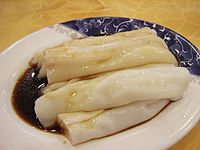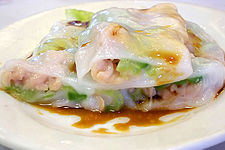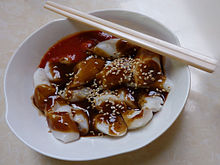- Rice noodle roll
-
Rice noodle roll Rice noodle rolls Traditional Chinese 豬腸粉 Simplified Chinese 猪肠粉 Cantonese Jyutping zyu1 coeng4*2 fan2 Cantonese Yale jyū chèuhng(chéung) fán Hanyu Pinyin zhū cháng fěn Transcriptions Mandarin - Hanyu Pinyin zhū cháng fěn Cantonese (Yue) - Jyutping zyu1 coeng4*2 fan2 - Yale Romanization jyū chèuhng(chéung) fán Alternative Chinese name Traditional Chinese 腸粉 Simplified Chinese 肠粉 Transcriptions Mandarin - Hanyu Pinyin cháng fěn Cantonese (Yue) - Jyutping coeng4*2 fan2 - Yale Romanization chèuhng(chéung) fán A rice noodle roll (also translated as steamed rice roll) is a Cantonese dish from southern China and Hong Kong, commonly served as a variety of dim sum. It is a thin roll made from a wide strip of shahe fen (rice noodles), filled with shrimp, pork, beef, vegetables, or other ingredients. Sweet soy sauce is poured over the dish upon serving. The rice noodle is also known as chee cheong fun where chee cheong means pig intestine, and fun means noodle; this is because the noodle resembles the small intestine of a pig.
Contents
Preparation
The rice noodle sheets are made from a viscous mixture of 1 cup of rice flour and 1/3 cup tapioca or glutinous rice flour and water, this recipe will scale well as long as the ratio of flours and water remain the same. The combination of both types of flour and water should be a consistency of heavy cream. The rice flour serves as the bulk and flavor of rice, the tapioca gives the elasticity and springiness, therefore it should never crumble nor being too chewy. It should never have the al dente texture as with Italian pasta.
This liquid mixture is poured into a specially made flat pan with holes (similar to a flat colander). Commercial restaurants use instead special over-sized steamers that are lined with a steam permeable cloth. The noodle mixture is steamed in the pan from the bottom up to produce the square rice noodle sheets. The thickness of the noodle should be very thin (roughly about ⅛ thickness), never thick, or it will have a gummy texture.
Once the liquid mixture is ladled and set, the chef can add a filling before the noodle is fully cooked. As the noodle is cooking, it will start to set around the filling and take hold without falling out when transferring from steamer to dish. After steaming for several minutes, the entire freshly steamed noodle is melded onto the cloth thereby the necessity to be scraped off with a scraper and onto a usually a metal table surface with a thin coat of oil to prevent sticking. The resulting freshly made noodle is lightly folded about three times. The resulting size is usually anywhere from 5-7 inches long by 3 inches wide. Traditionally, the noodles are usually finished off by adding a warm sweetened soy sauce just before serving to the customer's table.
Two common Cantonese words are typically used to describe a well-made rice noodle roll: "Haung" – meaning: good aroma. "Whaat" – meaning: smooth or slippery. The actual noodle by itself doesn't have much taste, it is just as bland as plain white steamed rice. The fillings and the sauce that accompanies it provides the bulk of the flavor. Traditional fillings are marinated fresh shrimp, beef, or pork.
Home made version: Avoid using round pans, the rolled rice noodles won't look uniform nor presentable. The sheets are done when they start to "bubble" after about 3-4 minutes covered tightly and under heavy steam. During steaming, any addition of meats or fillings should be added about 30 seconds after the mixture is poured in a greased "non stick" pan to let the noodle to set a bit, otherwise the fillings will settle to the bottom of the pan and separate and will tear the noodle when folding. Chee cheong fun – Cantonese\Hong Kong style is usually lightly folded (about 2 inches wide and about 4-6 inches long) when there is a filling inside, resulting in a much more pleasing look rather than a rolled up as a fruit roll up.
As mentioned earlier, presentation is very important when serving dim sum. The noodle, when fully cooked, should be slightly transparent to slightly reveal the filling. If the edges after folding are not lined up then the edges are to be cut to get that even look, similar to getting the outer crust cut off a sandwich. The rice noodle roll is generally served in "threes" and usually scored to reveal the filling inside. Most other countries will roll them plain with no filling inside and instead serve them with toppings and a heavy\thick sauce on top. The rice noodle roll is always served hot and fresh and accompanied with a splash of plain or flavored (fried shallot) oil to give it a nice sheen and aroma with a generous amount of warm sweet soy sauce added right before serving. Most establishments will have a slightly different flavor of sweet soy sauce such as an addition of hoisin sauce.
Regional
Cantonese cuisine
In Cantonese cuisine, rice noodle roll is most often served in dim sum. The most common types traditionally offered as part of dim sum cuisine are:
- Rice noodle roll with lightly marinated shrimp (蝦腸; Cantonese: haa1 coeng4)
- Rice noodle roll with beef -usually ground beef with heavy addition of corn starch as filler and promote tenderness(牛肉腸; Cantonese: ngau4 juk6 coeng4)
- Rice noodle roll with dried shrimp (蝦米腸; Cantonese: haa1 mai5 coeng4)
- Rice noodle roll with char siu (叉燒腸; Cantonese: cha1 siu1 coeng4)
Other modern varieties that may be offered include:
- Rice noodle roll with chicken and bitter melon
- Rice noodle roll with conpoy and pea shoot
- Rice noodle roll with fish
- Rice noodle roll with youtiao also known as zhaliang
Vietnamese cuisine
Main article: Bánh cuốnIn Vietnamese cuisine, there is a similar dish called bánh cuốn, and it is mostly eaten for breakfast. It is a crêpe-like roll made from a thin, wide sheet of rice noodle (similar to Shahe fen) that can be filled with ground pork and other ingredients. Sides for this dish usually consist of chả lụa (Vietnamese pork sausage) and bean sprouts, while the dipping sauce is called nước chấm. Sometimes, a drop of cà cuống, which is the essence of a giant water bug, Lethocerus indicus, is added to the nước chấm for extra flavor, although this ingredient is scarce and quite expensive.
Southeast Asian cuisine
In Singapore and Malaysian cuisine, In Malaysia, many people prefer serving chee cheong fun with a kind of black sweet sauce called (甜酱, timzheong). It is likely a variation of hoisin sauce. The popular Malaysian Penang version uses a shrimp paste called hae ko which is also black and sweet. Others prefer specially-made chili sauce or mix the two together. Chee cheong fun is a popular breakfast food in Singapore and Malaysia. Chee cheong fun is frequently served in kopitiams and Chinese restaurants.
Other variations
There is another kind of food which is similar to chee cheong fun, called laicheong (拉腸) in Cantonese. This food is popular in Guangzhou.
See also
Categories:
Wikimedia Foundation. 2010.



